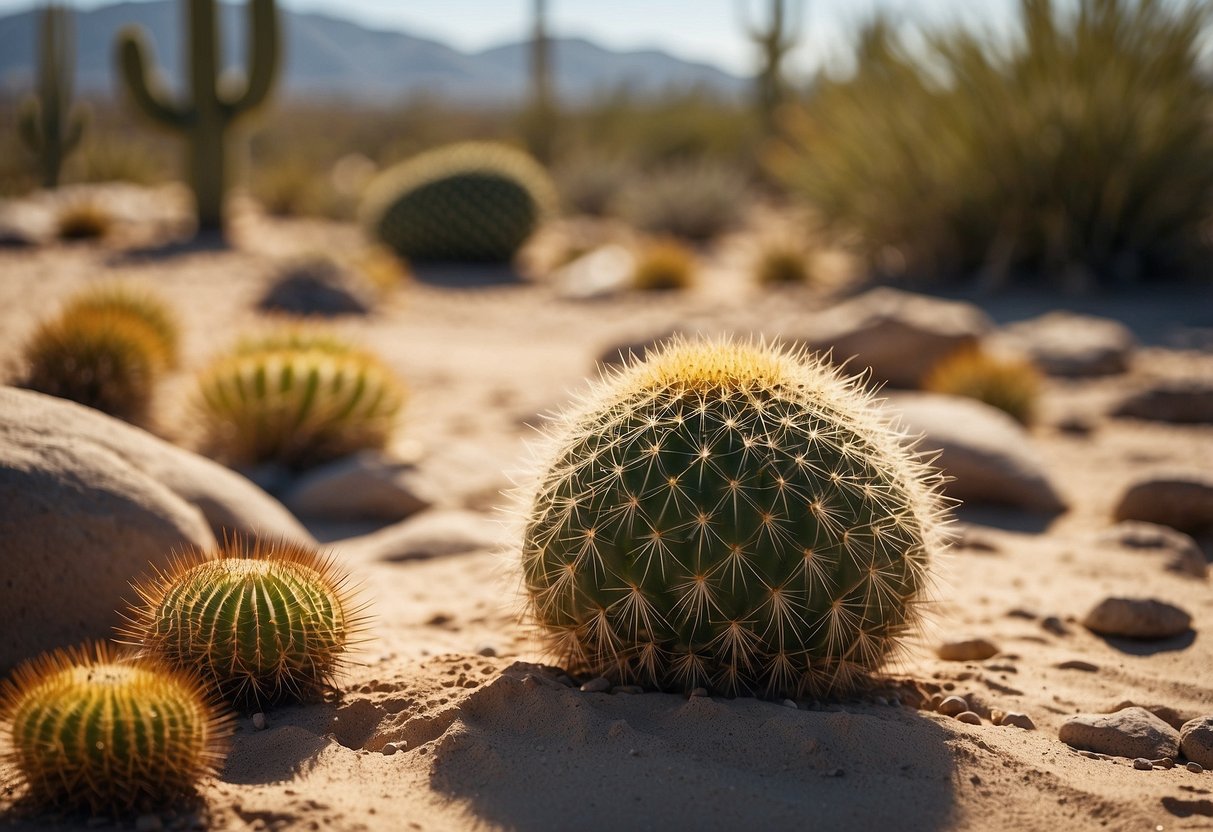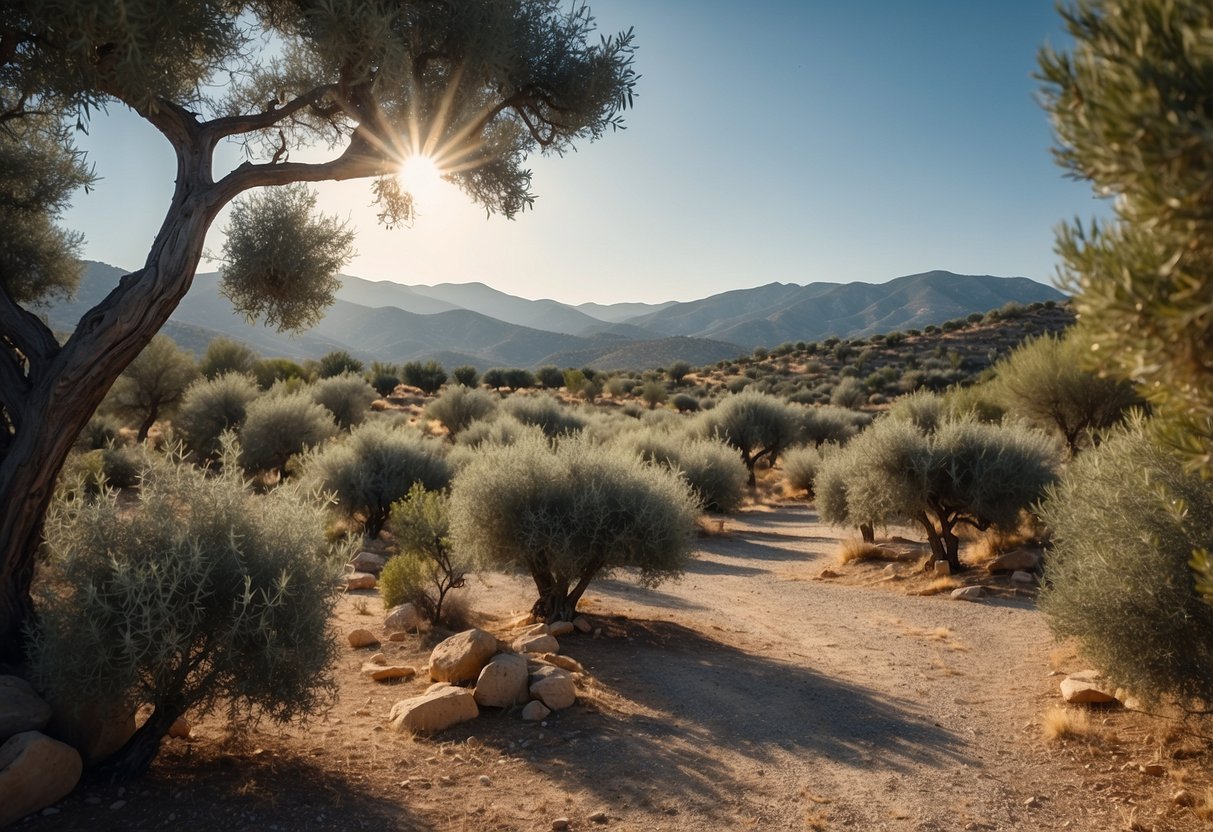Dry Garden Ideas: Creative Ways to Save Water
Thinking about turning your garden into a dry garden? This concept is perfect for areas with low rainfall or if you’re looking to reduce water usage. Dry gardens can flourish with the right planning and plant choices, offering a unique and beautiful landscape.

Dry gardens not only save water but also require less maintenance compared to traditional lawns. With the right mix of drought-tolerant plants and thoughtful design, you can create a stunning and sustainable garden that thrives in dry conditions.
1) Succulents

Succulents are perfect for dry gardens because they store water in their leaves, making them very low-maintenance. You can arrange different varieties to create eye-catching designs.
For example, you can surround a large agave with smaller succulents such as Echeveria or Ghost plants (source). Use rock mulch to help retain heat and enhance drainage (source).
These plants come in many colors and shapes, making your garden vibrant and interesting. Consider using dried sheet moss for a decorative touch while keeping it dry to avoid stem rot.
2) Cacti

Cacti are perfect for a dry garden. They need very little water and can thrive in hot, sunny areas.
There are many different types of cacti to choose from. The Mexican Fence Post Cactus is a great option for adding height and structure to your garden.
You can also add decorative elements like glass balls to create a unique look.
3) Yucca Plants

Yucca plants are perfect for a dry garden. They thrive in hot, sunny conditions and require little water. Their spiky leaves and tall flower spikes add unique texture and height to your garden.
You can pair yuccas with Texas sage, which also thrives in dry conditions. For a mix of colors, plant them alongside drought-tolerant perennials and succulents.
Try using smaller varieties like the dwarf nana yucca in the front of your beds. They create a striking visual when combined with other low-water plants.
4) Agave

Agave is a fantastic choice for a dry garden. These plants are incredibly resilient and require very little water. They thrive in full sun and well-drained soil.
Agaves come in various sizes and colors, ranging from the large Agave americana to the smaller Agave desmettiana. Their dramatic, spiky leaves add a striking visual element to your garden.
Pair agaves with other drought-tolerant plants like succulents and cacti. They look great with aloe vera and sedums. Adding some sand or grit to your soil can help with drainage, ensuring your agave stays healthy.
5) Lavender

Lavender is a fantastic plant for dry gardens. It thrives in sunny spots with well-drained soil. The plant is also low-maintenance, making it perfect if you don’t have a lot of time to spend on your garden.
You can even use dried lavender to create lovely scented sachets or infuse creams for a pleasant aroma. Its vibrant purple flowers add color and attract pollinators like bees and butterflies.
Underplanting trees with lavender helps fill bare soil areas and adds layers to your garden. This way, you create an interesting and beautiful landscape.
6) Olive Trees

Olive trees add a touch of the Mediterranean to your garden. They have beautiful gray-green leaves and can soften the look of fences and other hardscapes.
These trees do well in pots, making them perfect for small spaces. Pair them with fragrant herbs like rosemary or lavender for a stunning effect.
Olive trees thrive in sunny locations with well-drained soil. They’re drought-tolerant once established, which makes them a great choice for dry gardens. Make sure younger trees get enough water until they mature.
7) Drought-Tolerant Grasses

If you want a lush lawn that doesn’t need much water, you’re in luck. There are many grasses that thrive in dry conditions.
One great option is Prairie Dropseed. This grass has green flowers that can turn yellow, tan, or gray. It handles dry soil well.
Another choice is Fescue. It creates a green carpet and requires little maintenance, making it perfect for dry gardens.
8) Sedum

Sedum is a fantastic choice for a dry garden. These plants are known for their hardiness and drought tolerance, making them perfect for areas with less water.
There are many beautiful varieties, such as ‘Lime Joy’ with its lime-colored buds and magenta petals. They grow up to 15 inches tall and 18 inches wide, adding vibrant color to your garden.
Sedum plants thrive in full sun and well-drained soil. They are also great for rock gardens and borders. Some types only grow up to 3 inches tall, like Sedum acre, making them excellent ground covers. You can find more ideas for stunning sedum varieties here.
Sedum’s ability to withstand heat and cold makes it a versatile plant for different climates. Plus, it requires minimal maintenance, making your gardening experience more enjoyable. For more information on the best sedum plants, visit Better Homes & Gardens.
9) Bougainvillea

Bougainvillea is a fantastic option for dry gardens. This plant flourishes in hot weather and bright sunlight. It only needs about six hours of direct sun daily to bloom beautifully.
With its vibrant colors, bougainvillea can brighten up your garden. Whether you grow it on trellises, walls, or in hanging baskets, it will add a splash of color. Consider planting it in well-draining soil to prevent root rot and keep it thriving.
10) Rosemary

Rosemary is a fantastic choice for a dry garden. It thrives in hot, dry conditions and doesn’t need frequent watering.
This fragrant herb can handle slightly acidic or alkaline soils, making it versatile for different garden setups. It’s also resistant to pests and diseases.
Plant rosemary in a sunny spot with well-draining soil. Water deeply but let the soil dry out between watering. This helps prevent root rot.
Check out detailed growing tips from Birds and Blooms if you need more information.
Understanding Dry Gardens

Dry gardens are designed to thrive in arid conditions with minimal water. They use drought-tolerant plants and smart landscaping techniques to create a beautiful, sustainable garden.
What Is a Dry Garden?
A dry garden is a type of garden that uses plants and landscaping techniques suited for dry, arid climates. These gardens require less water compared to traditional gardens. Resilient plants like succulents, cacti, and native grasses often make up the plant selections.
Dry gardens also incorporate mulch and rocks to help retain moisture. These materials reduce the need for frequent watering, making maintenance easier. Thoughtful design ensures that water is used efficiently, supporting plant health without waste.
Benefits of Dry Gardening
Dry gardening has multiple benefits beyond just water conservation. For one, it requires less upkeep. Drought-resistant plants usually need less trimming and care, giving you more time to enjoy your garden.
This type of gardening also supports local wildlife. Plants that thrive in dry gardens often attract pollinators like bees and butterflies. Furthermore, these gardens can help manage stormwater runoff, reducing erosion and improving soil health.
Lastly, dry gardens can be visually striking. The contrast between different textures and colors creates a unique, appealing landscape that’s both beautiful and environmentally friendly. This approach lets you enjoy a lush, vibrant garden without worrying about water shortages.
Design Tips for Dry Gardens

Designing a dry garden requires careful plant selection and the incorporation of hardscaping elements. These choices will help ensure your garden is both attractive and drought-tolerant.
Choosing the Right Plants
Selecting the right plants is key to creating a successful dry garden. Focus on plants that are drought-tolerant, such as succulents, cacti, and lavender. These plants thrive in dry conditions and require minimal water.
Succulents and cacti store water in their leaves, making them ideal for dry gardens. Plants like lavender, santolina, and Russian sage have gray or silver foliage, which helps reduce water loss.
Incorporate ground cover plants like North American native fescues. These plants can replace lawn grass, which may turn brown during droughts. They also add greenery and help with erosion control.
Incorporating Hardscaping Elements
Hardscaping elements are essential for dry garden design. Use materials like gravel, stone, and mulch to reduce water evaporation. A layer of mulch helps keep soil moist and prevents weeds from taking over.
Gravel paths and stone borders enhance the aesthetic of your garden. Consider adding seating areas and decorative features like rock gardens. These elements not only save water but also provide a low-maintenance space.
Raised beds can improve drainage and create focal points. Use terracotta pots for planting, which can help moderate soil temperature and moisture levels. Integrating hardscaping with plants creates a balanced, practical garden space.
Maintenance and Care

Keeping your dry garden healthy involves efficient irrigation and proper soil care. Water-saving techniques and mulching will be key to maintaining a beautiful, drought-tolerant landscape.
Efficient Irrigation Methods
Maximizing water usage is crucial. Drip irrigation is a great option. It delivers water right to the plant roots, minimizing evaporation.
You could also consider using soaker hoses. These hoses slowly seep water into the soil, offering deep hydration with minimal waste.
Water timing is vital. Water your plants early in the morning or late in the evening to reduce evaporation. Arrange your plants into zones based on their water needs to ensure each plant gets the right amount.
Rain barrels can be a helpful addition. Collecting rainwater gives you a free, eco-friendly water source you can use during dry spells.
Soil Preparation and Mulching
Good soil is the foundation of a healthy dry garden. Start with well-draining soil. You might need to mix sand or gravel into your existing soil to improve drainage.
Adding organic matter such as compost can enhance soil fertility. This not only provides nutrients but also helps the soil retain moisture.
Mulching is your best friend. A layer of mulch can significantly reduce water loss and keep weeds at bay. Use organic mulch, like wood chips or straw, for added nutrients and a natural look.
Don’t forget to regularly check the pH levels of your soil. Many drought-tolerant plants prefer slightly acidic to neutral pH.
For a final touch, replenish your mulch each year. This keeps your garden looking fresh and maintains its water-saving benefits.







